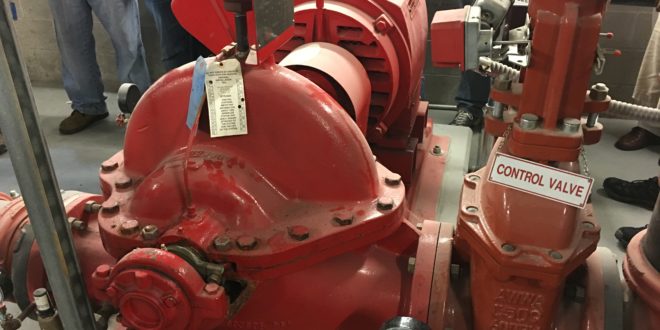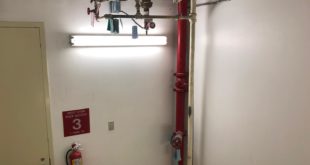Accepted Changes and Additions
The NFPA 20 committee has completed the review process and update of the 2019 edition of NFPA 20, Standard for the Installation of Stationary Pumps for Fire Protection, and it is ready for distribution to the public. This article highlights some of the important results of the committee’s review of the Public Proposals and Comments.
The results were presented to the NFPA membership at the annual meeting in Las Vegas in June. No one offered a NITMAM for change and the committee’s work was voted on and accepted by the membership present.
Even with the comparatively small number of proposals offered this cycle, there were plenty of items of work for the committee. The committee had to contend with shortened sessions due to hurricanes in Florida and Texas, the two meeting destinations. The committee was required to use several teleconferences to complete the proposal review.
With an ever-changing industry landscape, we are presented with many new products and claims “of the best gadget you have ever seen” entering the industry on a continuing basis. The committee must sift through these items to ensure a proper review is offered upon each proposal. Some of the proposals presented this cycle did afford just such a challenge to the committee.
Chapters 1 and 2 are virtually unchanged from the preceding edition. Chapter 1 is unchanged. Chapter 2 reference publications received the normal updates for the referenced publications.
Throughout the new 2019 edition of NFPA 20, the text changes are highlighted by shaded areas and bullets for new sections, deletions, and new material. The new marking system in this edition is a real improvement when researching or identifying the changes and additions made in the standard.
Changes to Chapter 3 “Definitions” include additions and clarifications to the variable speed pump controllers and the addition of new equipment such as self-regulating pump controllers and self-regulating variable speed fire pump. These new products are included in addition to the previously approved variable speed pressure limiting and suction limiting controllers. Refer to section 3.3.76 Variable Speed Pumps and Controllers for new definitions related to the addition of the self-regulating control.
Clarifications are included to better identify the different variable speed options. Refer to section 3.3.75.2 through section 3.3.76.5 for the list of options. (section 3.3.76.2*).
One of the more interesting proposals received relates to remote distance monitoring for the periodic fire pump no-flow test. There are many devices available to allow development of a remote periodic test of the fire pump system. Providing a remote monitoring system to replace the normal inspection, testing, and maintenance (ITM) periodic test and inspections will require a lot of pre-planning and engineering in addition to the standard or custom NFPA 20 installation.
The remote monitoring equipment required to provide the necessary data delves into a lot more electronics such as cameras, thermal screening, video, and other electronic devices.
As the representative for the American Fire Sprinkler Association (AFSA), we voted to reject both of these proposals. In our evaluation, we could not determine that these proposed items added any value or better fire protection for the end-user.
Adding self-regulating pumps and remote monitoring to the standard added several areas of concern. We as fire sprinkler professionals must evaluate the application of these products to ensure we provide the fire protection needed by our customers.
The new self-regulating variable speed pump system is totally different in concept when compared to the variable speed controls used extensively in excess pressure and suction control applications.
As fire protection professionals and licensed fire sprinkler contractors, you should pay more attention to determining the exact cause and effect of problems we encounter during design, installation, and operating of fire pump systems. Record this information and make it available for future reference. The need for more and more factual record keeping is becoming an everyday requirement. Stay ahead of the game and establish an in-depth event recording program.
Chapter 4 General Requirements, reflects a large number of text changes that include clarifications in section 4.2* Pump Approvals and Section 4.3 Pump Operation (4.3.1*).
Beginning at Chapter 4 section 4.7.7.3 through section 4.8.24 Variable Speed Pump, there are 28 new sections dedicated to the design criteria and operating guidance for the new self-regulating fire pump system (4.8.16*).
Additionally, new guidance is provided for use of water flow devices. Beginning at section 4.22 Water Flow Test Devices through section 4.22.1.2.5. (4.22.1.1* and 4.23.1.3*).
New section 4.35 Automated Inspection, Testing, and Distance Monitoring of Devices, Meters, and Equipment outlines a new concept for monitoring the fire pump equipment during a performance test and the regular ITM functions.
Sections 4.35.1* and 4.35.2* list the devices and equipment that can be monitored remotely.
Chapter. 5 Fire Pumps for High-Rise Buildings, has modest texts changes and several new sections. The chapter offers new guidance for the water supply requirements for section 5.6* Very Tall Buildings. Information provided includes new guidance and design info for the extensive cross connections required for refill and replenishment backup through the use of tankage in the upper floors of the structure. New text information is included beginning with section 5.6.1.1* which outlines new guidance for high rise building and continues through section 5.6.1.6*.
Refer to sections 5.6.1.5 through 5.6.1.6.6 for new text and design requirements in tall buildings.
Chapter 6 Centrifugal Pumps has minor changes to the text. Additional guidance is added for use in setting up the variable speed pumps. See sections 6.1.1*; 6.2.2.2; and 6.2.2.3, operating guidance.
Chapter 7 Vertical Shaft Turbine Pumps has minor text changes. New requirements for mass elastic torsional analysis is provided for the manufacturer’s use in obtaining listings for their vertical shaft pumps where right angle gear drives are used.
Chapter 8 through Chapter 13 have minor changes to the text, and a notable change to the motor service factor requirements for variable speed drive units using VSD controllers and the new self-regulating fire pump units (see section 9.5.2.2).
The major changes in Chapter 14 Acceptance, Testing, Performance, and Maintenance center on the new automated inspection and testing devices and equipment, ITM feature, and testing guidance for the self-regulating fire pump. Refer to sections 14.2.4.1.3 through 14.2.6.2.3 for the basic information needed to use the automated monitoring.
The new automated inspection feature must dovetail into the requirements of NFPA 25, Standard for the Inspection, Testing, and Maintenance of Water-Based Fire Protection Systems, and NFPA 72®, National Fire Alarm and Signaling Code®.
AFSA needs your input and comments related to your concerns and successes in the fire pump industry. Any new methods or equipment added in the design, installation, and performance of fire pump systems often times create concerns that should be addressed by the association. Be an advocate for a better product. The fire pump has always been a tough piece of equipment, designed to withstand abuse and minimum service and continue to perform all the way to destruction. The trend to more solid state components will make the units less robust. It is up to the fire protection professional to evaluate the available equipment and make the right choices to accomplish the mission to provide good fire protection for the customer.
ABOUT THE AUTHOR:
Bill M. Harvey, SET, is with Harvey & Associates, Inc. in Fountain Inn, South Carolina. Contact Harvey via email at bill@harveyandassociates.com.
IMPORTANT NOTICE:
As a member of the NFPA Technical Committee for NFPA 20, the following disclaimer applies. This article and its content is not a Formal Interpretation issued pursuant to NFPA Regulations. Any opinion expressed is the personal opinion of the author and presenter and does not necessarily represent the official position of the NFPA and its Technical Committee.
 Sprinkler Age A Publication of the American Fire Sprinkler Association
Sprinkler Age A Publication of the American Fire Sprinkler Association

